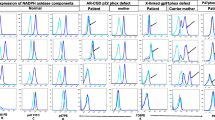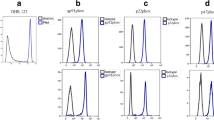Abstract
Introduction
Chronic granulomatous disease (CGD) is an inherited mutational defect in any of the NADPH oxidase complex, CYBB (gp91-phox), NCF1 (p47-phox), CYBA (p22-phox), NCF2 (p67-phox), or NCF4 (p40-phox) leading to inability of phagocytes to perform effective respiratory burst and thus diminished killing of bacteria and fungi. The identification of defective proteins aids in establishing a diagnosis prior to genetic analysis, which is rather labor-intensive, expensive, and time-consuming.
Aim
The present study aims at assessing the NADPH proteins by performing the intracellular staining with specific monoclonal antibodies and their assessment on flow cytometry. The use of flow cytometry is less laborious and faster to perform than western blot. It also confirms the diagnosis of CGD and detects the affected components allowing proper management of patients.
Materials and Methods
Twenty-eight patients from 25 different kindred, clinically suspected as CGD were recruited in Egypt. Dihydrorhodamine test was performed to confirm the diagnosis of the patients. Intracellular staining of NADPH components using specific monoclonal antibodies was performed followed by flow cytometric analysis.
Results
The present study revealed that the most common defective protein in our cohort is p22-phox, found in 13 patients (46.4 % of cases) followed by p47-phox in 8 patients (28.6 %), gp91-phox in 5 patients (17.9 %), and finally p67-phox in 2 patients (7.1 %).
Conclusion
In countries with limited resources and yet large number of CGD patients, the analysis of the defective proteins by flow cytometry is an optimum solution for confirming the diagnosis and is a step for targeted sequencing in families seeking prenatal diagnosis.


Similar content being viewed by others
References
Suliaman F, Amra N, Sheikh S, Almuhsen S, Alsmadi O. Epidemiology of chronic granulomatous disease of childhood in Eastern Province, Saudi Arabia. Pediat asthma, Allergy immunol. 2009;22(1):21–6.
Roos D, De Boer M, Yavuz Koker M, Dekker J, Singh-Gupta V, Ahlin A, et al. Chronic granulomatous disease caused by mutations other than the common GT deletion in NCF1, the gene encoding the p47phox component of the phagocyte NADPH oxidase. Hum Mutat. 2006;27(12):1218–29.
Ben-Ari J, Wolach O, Gavrieli R, Wolach B. Chronic granulomatous disease: linking genetics to phenotypic expression. Expert Rev Anti Infect Ther. 2012;10(8):881–94.
Koker MY, Metin A, Özgür TT, De Boer M, Roos D. Prenatal diagnosis of chronic granulomatous disease in a male fetus. Iran J Allergy Asthma Immunol. 2009;8(1):57–61.
Rezvani Z, Mohammadzadeh I, Pourpak Z, Moin M, Teimourian S. CYBB gene mutation detection in an Iranian patient with chronic granulomatous disease. Iranian J aller, asthma Immunol. 2005;4(2):103–6.
Battersby AC, Cale CM, Goldblatt D, Gennery AR. Clinical manifestations of disease in X-linked carriers of chronic granulomatous disease. J Clin Immunol. 2013;33(8):1276–84.
Meshaal S, El Hawary R, Abd Elaziz D, Alkady R, Galal N, Boutros J, et al. Chronic granulomatous disease: review of a cohort of Egyptian patients. Allergol Immunopathol. 2015;43(3):279–85.
Yu G, Hong DK, Dionis KY, Rae J, Heyworth PG, Curnutte JT, et al. Focus on FOCIS: the continuing diagnostic challenge of autosomal recessive chronic granulomatous disease. Clin Immunol. 2008;128(2):117–26.
Baba LA, Ailal F, El Hafidi N, Hubeau M, Jabot-Hanin F, Benajiba N, et al. Chronic granulomatous disease in Morocco: genetic, immunological, and clinical features of 12 patients from 10 kindred. J Clin Immunol. 2014;34(4):452–8.
Dimitrova G, Bunkall C, Lim D, Kendrick C. Comparison of two methods for the diagnosis of chronic granulomatous disease – neutrophil oxidative burst measured by the nitro blue tetrazolium slide test versus the dihydrorhodamine 123 flow cytometric assay. N Z J Med Lab Sci. 2013;67:45–51.
Van Pelt LJ, Van Zwieten R, Weening RS, Roos D, Verhoeven J, Bolscher BG. Limitations on the use of dihydrorhodamine 123 for flow cytometric analysis of the neutrophil respiratory burst. J Immunol Methods. 1996;191(2):187–96.
Holland SM. Chronic Granulomatous Disease. Clinic Rev Allerg Immunol. 2010;38:3–10.
Mauch L, Lun A, O’Gorman MR, Harris JS, Schulze I, Zychlinsky A, et al. Chronic granulomatous disease (CGD) and complete myeloperoxidase deficiency both yield strongly reduced dihydrorhodamine 123 test signals but can be easily discerned in routine testing for CGD. Clin Chem. 2007;53:890–6.
Bakri FG, Martel C, Khuri-Bulos N, Mahafzah A, El-Khateeb MS, Al-Wahadneh AM, et al. First report of clinical, functional, and molecular investigation of chronic granulomatous disease in nine Jordanian families. J Clin Immunol. 2009;29:215–30.
Cross AR, Noak D, Rae J, Curnutte JT, PG H. Hematologically important mutations: the autosomal recessive forms of chronic granulomatous disease (first update). Blood Cells Mol Dis. 2000;26(5):561–5.
El Kares R, Barbouche MR, Elloumi-Zghal H, Bejaoui M, Chemli J, Mellouli F, et al. Genetics and mutational heterogeneity of autosomal recessive chronic granulomatous in Tunisia. J Hum Genet. 2006;51:887–95.
Koker MY, Camcioglu Y, Van Leeuwen K, Sebnem Kılıc S, Barlan I, Yılmaz M, et al. Clinical, functional, and genetic characterization of chronic granulomatous disease in 89 Turkish patients. J Allergy Clin Immunol. 2013;132(5):1156–63.
Kannengiesser C, Gérard B, El Benna J, Henri D, Kroviarski Y, Chollet-Martin S, et al. Molecular epidemiology of chronic granulomatous disease in a series of 80 kindreds: identification of 31 novel mutations. HUMAN MUTATION. 2008;29:E132–49.
Kim YM, Park JE, Kim JY, Lim HK, Nam JK, Cho M, et al. Genetic analysis of 10 unrelated Korean families with p22-phox-deficient chronic granulomatous disease: an unusually identical mutation of the CYBA gene on Jeju Island, Korea. J Korean Med Sci. 2009;24:1045–50.
Kuhns DB, Alvord WG, Heller T, Feld JJ, Pike KM, Marciano BE, et al. Residual NADPH oxidase and survival in chronic granulomatous disease. N Engl J Med. 2010;363:2600–10.
Kannengiesser C, Gérard B, El Benna J, Henri D, Kroviarski Y, Chollet-Martin S, Gougerot-Pocidalo M A, Elbim C and Grandchamp B. Molecular epidemiology of chronic granulomatous disease in a series of 80 kindreds: identification of 31 novel mutations. HUMAN MUTATION. 2008 #1019, 29:E132-E149.
Porter CD, Parkar MH, Verhoeven AJ, Levinsky RJ, Collins MK, Kinnon C. p22-phox-deficient chronic granulomatous disease: reconstitution by retrovirus-mediated expression and identification of a biosynthetic intermediate of gp91-phox. Blood. 1994;84:2767–75.
Teimourian S, Zomorodian E, Badalzadeh M, Pouya A, Kannengiesser C, Mansouri D, et al. Characterization of six novel mutations in CYBA: the gene causing autosomal recessive chronic granulomatous disease. Br J Haematol. 2008;141:848–51.
Koker MY, Van Leeuwen K, de Boer M, Elmeli FC, Metin A, Ozgur TT, et al. Six different CYBA mutations including three novel mutations in ten families from Turkey, resulting in autosomal recessive chronic granulomatous disease. Eur J Clin Invest. 2009;39(4):311–9.
Wolach B, Gavrieli R, de Boer M, Gottesman G, Ben-Ari J, Rottem M, et al. Chronic granulomatous disease in Israel: clinical, functional and molecular studies of 38 patients. Clin Immunol. 2008;129:103–14.
Manea S-A, Constantin A, Manda G, Sasson S, Manea A. Regulation of Nox enzymes expression in vascular pathophysiology: focusing on transcription factors and epigenetic mechanisms. Redox Biol. 2015;5:358–66.
Acknowledgments
This work is funded by Cairo University. We would like to thank the Molecular Genetics Laboratory, Centre for Cardiovascular Surgery and Transplantation, Brno, Czech Republic, for performing Sanger sequencing to detect the molecular mutations and The Laboratory of Human Genetics of Infectious Diseases which is supported by institutional grants from INSERM, University Paris Descartes, The Rockefeller University, and the St. Giles Foundation and grants from the French National Research Agency (ANR) under the “Investments for the Future” program (grant no. ANR-10-IAHU-01) and grant IFNGPHOX (no. ANR13-ISV3-0001-01).
Author information
Authors and Affiliations
Corresponding author
Ethics declarations
Conflict of Interest
Authors declare they have no conflict of interest.
Additional information
Rabab El Hawary and Safa Meshaal equally contributed to this work, Taghrid Gaafar and Aisha Elmarsafy share senior coauthorship.
Electronic supplementary material
Below is the link to the electronic supplementary material.
ESM 1
(GIF 33 kb)
Rights and permissions
About this article
Cite this article
El Hawary, R., Meshaal, S., Deswarte, C. et al. Role of Flow Cytometry in the Diagnosis of Chronic Granulomatous Disease: the Egyptian Experience. J Clin Immunol 36, 610–618 (2016). https://doi.org/10.1007/s10875-016-0297-y
Received:
Accepted:
Published:
Issue Date:
DOI: https://doi.org/10.1007/s10875-016-0297-y




